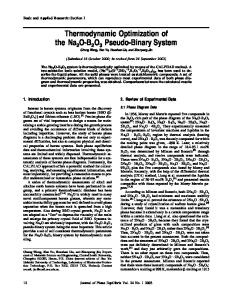Thermochemistry of Na 2 O-WO 3 system at 1065 to 1239 K
- PDF / 767,667 Bytes
- 8 Pages / 603.28 x 788 pts Page_size
- 5 Downloads / 318 Views
I.
THEwork reported here is part of a broader program on the study of the thermodynamic properties of liquid binary and ternary salts that may participate in the hot corrosion of metals and ceramic materials. Tungsten is a constituent of superalloys, and WO3 combines with Na20 to form a lowmelting liquid (see Figure 1). The sodium oxide may be formed from sodium salts in the combustion air and fuel of oil- or gas-fired turbines and of boilers. Earlier work on the Na-W-O ternary system has been concentrated on the sodium-tungsten bronzes (NaxWO3) because of the high conductivity of sodium ions in them. 3 These bronzes oxidize to form the tungstates when the equilibrium oxygen pressure rises above 10-~~ atm at 750 ~ 4 Thus, in the study reported here where the oxygen pressure was always greater than or equal to 0.05 atm, the stable phases for the Na-W-O system lie along the Na20-WO3 binary joint. The portions of the phase diagram for this binary system have been determined by Hoermann, 5 Caillet,: Sakka, 6 and Chang and Sachdev, l each employing a different experimental technique. Only Chang et al. and Caillet completed work for the composition range between Na2WO4 and WO3. Figure 1 is a composite of their results. There is disagreement between the results of the two works regarding the stability of the Na20 9 6 W O 3 phase. Chang and Sachdev ~ studied the reactions in the solid state and analyzed the results by X-ray whereas Caillet2 utilized DTA measurements. The former workers reported the existence of the phase and Caillet did not. Sakka6 also showed that the phase exists, hence it is included in Figure 1. Based on the work of King and Weller7 and Goranson and Kracek, s the properties of Na2WO4 at elevated temperatures have been tabulated in the JANAF Tables. 9 II.
THE
EXPERIMENTS
The emf cell employed in this work utilized a sodium/3-alumina electrolyte: R. Y. LIN, formerly with GTE Labs, Waltham, MA 02145, is now with Energy Lab, Massachusetts Institute of Technology, Cambridge, MA 02139. J. F. ELLIOTT is Professor of Metallurgy, Massachusetts Institute of Technology, Cambridge, MA 02139. Manuscript submitted December 31, 1982. METALLURGICALTRANSACTIONS A
I
I
INTRODUCTION 1,200
1186
/ /
11o9
1,100
I
1013.5
I I
1,00C
900
I
! N
0.5
I
0.6
0.7
0.8
0.9
1.0
Nw Fig. 1 --Phase diagram of the Na20-WO3 system. After Chang et al. and Caillet. 2
W(s), WS2(s) Na +, O2(g), (Na20), Pt Na2S(s) /3-alumina (Na20-WO3 melt) This type of cell has been used in earlier studies in our laboratory, and it and its preparation are described elsewhere.~~ A diagram of the cell is shown in Figure 2. The parentheses around Na20 indicate that it is dissolved in the melt at the electrode on the right (the cathode). The electrode reactions are: at the anode: Iw(s) 2
+ Na2S(s) = 1WS2(s) + 2Na + + 2e2
[1]
and at the cathode: VOLUME 14A, AUGUST 1983-- 1713
~_ Gas ~let
p,
pure solid tungsten and pure oxygen gas at 1 atm pressure. For the experimental system, Eq. [4] reduces to
Tygon tube Rubber tube Added material
Data Loading...











